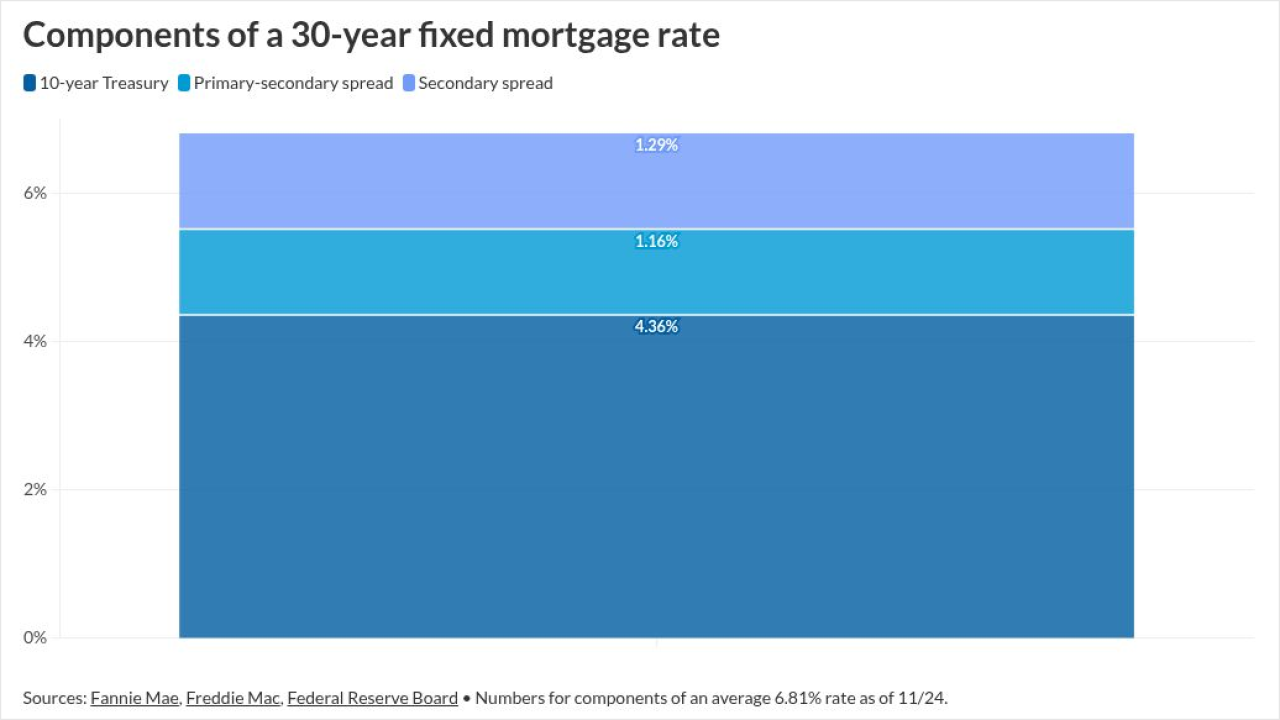Democratic presidential candidates looking for ways to impress younger, progressive voters have zeroed in on the nation’s estimated $1.5 trillion in student debt as a way to gain political points.
Several of the candidates have proposed sweeping changes to student lending, with some going as far as suggesting forgiveness of much, and in some cases all, of that outstanding debt.
Left undiscussed is what might happen to investors who hold securities backed by such debt. Student-loan asset-backed securities, or SLABs, constitute a $175 billion market, mostly of private loans and legacy Federal Family Education Loan Program (FFELP) government-backed loans that were last issued in 2009 before the advent of the federal direct-loan program introduced during the Obama administration.
While extreme change is viewed as an unlikely prospect, it is noteworthy that some of the most dramatic proposals come from candidates who are polling fairly well at this point, Sens. Elizabeth Warren and Bernie Sanders.
Under Warren’s proposal, all federal student-loan debt balances would be wiped clean for 75% of households, based on an income eligibility scale that would leave the debt intact for households making more than $250,000 per year. The Urban Institute calculates this would forgive 66% of the $1.48 trillion in federally guaranteed student loan debts in the country.
The cost to taxpayers? About $955 billion, according to the Washington economics and social policy research think tank. Warren’s plan would fund the plan through an annual 2% “ultramillionaire” tax.

Sanders’ “College for All” plank goes even farther. His proposal would wipe out all the nation’s student loan debt with no eligibility criteria for any borrower, including both federal and private student loans. Sanders would pay for debt forgiveness and his other higher education initiatives such as free public tuition through new transaction fees imposed on Wall Street (including stock, bond and derivatives trades).
Other candidates, including former Vice President Joe Biden and former San Antonio Mayor Julian Castro, have voiced support or discussed informal plans to introduce forgiveness programs in their proposals to lower or free up the cost of college tuition.
Investors and analysts, while handicapping broad student-loan debt forgiveness as a long shot, don’t rule out potential damage ahead for SLABs noteholders should the campaign promises evolve into formal policies in a new administration, even if those policies fall well short of the campaign pledges being voiced now.
“When you’re talking about forbearance and forgiveness, when you’re talking about extending maturities on loan terms, those are a lot of risks that investors can’t get their hands around,” said Mike Sheldon, a principal and senior portfolio manager on the securitized team at Income Research + Management, a fixed-income specialist for institutional and private-client investors.
To date, no candidate (perhaps not surprisingly) has proposed how investors in hundreds of private and federal-student loan securitizations would be compensated in the event of wholesale loan forgiveness or an expansion of loan modification programs. Analysts speculate those would involve greater income-based repayment offerings or refinancing of high-rate private loans through the lower-cost federal direct loan program.
But market observers are wondering aloud how, or if, investors will be made whole.
“We don’t know what’s going to be forgiven, we don’t know who’s going to qualify, we don’t know how investors of loans that are forgiven would be made whole,” said Jon Riber, a senior vice president and ABS analyst at Kroll Bond Rating Agency. “Will it be a big prepayment, or would it be just ‘too bad’?”
Of the major risks contemplated for investors, principal loss to trusts is considered the most remote. Few imagine a scenario in which seasoned or rehabbed FFELP loans, for example, would not be covered by the 97% federal guarantee of principal promised to investors in ABS deals sponsored by issuers such as Navient Corp. Nelnet Inc. or the Pennsylvania Higher Education Assistance Authority (PHEAA).
But if these loan debts were swept away, the prepayments on the ABS notes could certainly cut into the expected long-term returns.
In a July 31 report on the SLABs sector, Moody’s wrote that forgiveness would provide a temporary boost to the economy – but would ultimately shave potential future income of private lenders and servicers such as Navient, NelNet and SLM Corp. Those firms “would lose out on future net interest income on existing loans, which would negatively affect both the student loan lenders and ABS sponsored and serviced” by those issuers.
“If there’s a big trunk of prepayments, you’re right – the investors expecting certain yields over this amount of time are getting their yields cut short,” said Nicky Dang, a senior vice president and consumer ABS ratings analyst for Moody’s Investors Service, in an interview.
Moody’s report did not estimate the size of potential loss of yield across the sector, but those concerns over the presidential hopeful’s proposals have not threatened the stable outlook for the sector.
Geoff Caan, a portfolio manager for SLC Management in Wellesley, Mass., says FFELP ABS investors such as his firm have already accounted for the expected long-term impact of prepayments from current forbearance and income-based repayment programs. Most FFELP deals already have sizeable cushions against principal loss based on these outcomes, especially after both Fitch Ratings and Moody’s adopted new ratings criteria two years ago anticipating the stretched-out maturities from IBR programs. “There’s already been a debt forgiveness program, for teachers and people who work for the government in certain areas,” said Caan. “This will be expanding on that.”
More prepayments would be less a concern because “the people invested in those would still be shocked to see any defaults or levels of forgiveness that would come close to principal losses on the subordinate side,” said Caan. “Some still have excess spread within the deals, which would be borne out by the issuer.”
Prepayments on private SLABs also continue to accelerate, but analysts say it’s a twofold trend. The continued strong economy is supporting a strong labor market allowing borrowers to accelerate payments. Also, more higher-end borrowers are turning to low-cost refinancing programs of lenders like Social Finance and CommonBond that target the well-to-do graduate professionals of top colleges. SoFi, CommonBond and Navient (through its 2017 acquisition of Earnest) have increased their volume to 23% of the private SLABs issuance markets, according to an August student-loan sector report from Moody’s.
Student debt forgiveness has risen to prominent in public policy circles because of the increasing strain the loans are placing on U.S. households. According to the New York Federal Reserve, the average student loan balance is more than $37,000.
Millennials are staving off career pursuits, marriage, or homebuying because of the budget burden of loan repayments. Boomers and Gen X borrowers (who still hold most of the outstanding debt) are being challenged to adequately prepare for retirement on their legacy college-age obligations.
And borrowers are becoming increasingly pressed to keep up with their payments.
In the New York Fed’s household debt and credit report published in August, about 10.8% of all student debt was in post-90-day delinquency status in the second quarter of 2019.
But those numbers include defaults and delinquencies from the federal direct loan program. For private loans and legacy FFELP deals, delinquency and charge-off rates are less severe. Private loans are underwritten to borrower credit, unlike direct loans, and the FFELP loans apportioned to securitizations are more seasoned, with long historical payment performances behind them.
For the $449 billion in outstanding securitized FFELP loans, 90-day-plus delinquencies were up to 4.5% from 4.2% in the first quarter, but down from 5.3% a year ago, according to a student-loan ABS update published in August by Morningstar Inc.’s DBRS. About 9.7% of the loan balances were in forbearance.
Charge-offs within private SLABs were up slightly in the second quarter (2.2%) compared to the same period in 2018 (2%), but loan forbearance declined to 1.9% compared to 2.5% in the second quarter of 2018 (due to continued low unemployment that boosts on-time repayments on loans).
But will delinquencies and defaults stay this low in the event of wide-scale loan forgiveness? What could be a problem for investors is how debt forgiveness might create behavioral incentives that could cause deterioration in deal performance.
Student-loan borrowers currently are incentivized to keep up payments because most government-backed and private student loans are debts that can’t be discharged in bankruptcies. Joe Grohotolski, a vice president for Moody’s SLABs rating team, wonders whether the “nuance effects” of debt forgiveness program proposals would affect that dynamic.
“If [forgiveness] looks more real and more imminent, you might see a slowdown in payments as people aren’t going to prepay their loans if they think they’re going to be forgiven,” he said. “People might even default on them knowing they might be forgiven.”
“Obviously,” said Kevin J. O’Brien, a Chicago-based attorney representing third-party insurers of student loans, “if you went down the road with just a blanket debt forgiveness, the effect on that would be incredibly significant in terms of ... how people would go about dealing with it.”
One indicator of how consumers might behave if they expected forgiveness might be discerned from court dockets.
More borrowers are increasingly challenging the validity of their defaulted student loan debt, in defense of lawsuits that brought by the National Collegiate Student Loan Trusts (NCSLT) and other debt collectors.
They are buoyed by state and federal government lawsuits that allege overly aggressive (and allegedly illegal) collection practices, and their lawyers are revisiting the prove-the-debt strategies used by fend off home foreclosures during the mortgage crisis.
In its 2017 lawsuit against the NCSLT, the Consumer Financial Protection Bureau sued over the trusts’ attempt to collect over defaulted student loans they “couldn’t prove was owed or was too old to sue over,” according to a 2017 CFPB press release.
In Louisiana and Ohio state appeals courts, borrowers who defaulted on student loans have successfully used documentation deficiencies to overturn lower-court judgments against them in lawsuits brought by the national student loan trusts. In the 2016 Ohio case, an Ohio appeals court cited the fact the NLCSLT “did not include documentation to directly link the pool of debts” assigned to the trust from the borrower’s originating bank.
“These loans get passed from servicer to servicer, and they [collectors] would get affidavits saying all these loan records are here, when there was nothing to be had,” said O’Brien.
Some have argued this litigation risk represents a dire threat to SLABs in much the same way they harmed mortgage-backed securities. But those deals were on collateralized on shaky property values and subprime borrowers.
Nicky Dang of Moody’s counters that student loan-backed securities have the underpinning of careful underwriting by private lenders, issuing to well-qualified borrowers or their parents. And legacy FFELP loans (like today’s direct loans) bear the backing of the full faith and credit of the U.S. government.
Whether by court decree or presidential action, any borrower payment to a SLABs investor is going to be covered, she says.
“There is no certainty what a court ruling can do to the sector,” said Dang. But “if the government nullified loans, and would let the private-sector investors take a loss ... I think it’s tough for me to swallow.”




